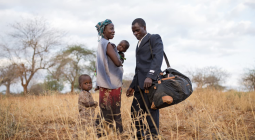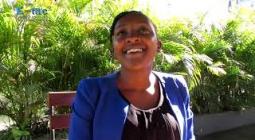Α sunrise or a sunset at the Μaasailand.
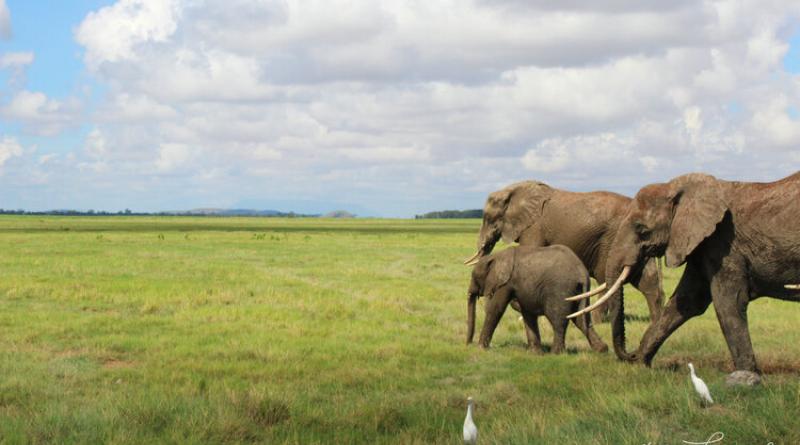
The Kuku Group Ranch is a private conservancy reserve in the Chyulu Hills of South Kenya. Only 80 km away from the Tanzanian border, on the foothill of Mount Kilimanjaro, the Maasai communities of the Chyulu Hills live an ongoing fight to survive the dramatic yearly climate alterations at this site of the Equator. Every year in East Africa, two rainy seasons (one starting in October and a second one in May) succeed two dry ones. This climate pattern is the main driver behind the famous seasonal wildlife migration that takes place every year in East Africa. Every year, wildebeest, zebras, elephants and their predators follow the emerging grasslands along a pathway from Kenya to Tanzania and backways. This pathway has been carved for centuries. In a similar way, the resilient Maasai have learned how to master the seasonal climate shifts and live a nomadic life with their livestock. Over generations the Maasai pastoralists of the Kuku group ranch and their cattle were moving from grassland to grassland across the Chyulu Hills, co-existing closely with the extraordinary wildlife of the savannah, continually adjusting to the demands of a variable climate. The Maasai are ambassadors of an ancient culture, customs and knowledge that may provide the world with significant lessons on climate change adaptation and nature conservation.
However, the existence of the Maasai tribe at this time is at risk. As pastoralists with an oral culture, they have lower levels of literacy which consequently leads to poor representation in their countries’ parliaments. The Maasais’ land rights are not well constitutionalized and are not included in land policies. When decisions are made concerning the Maasai lands, their communities are left out of the process. Development policies also fall into error. During recent decades, the development programmes across rural Africa were applying a type of community settlement around one borehole, one school and one medical center. In that way, access to education, food, water, and healthcare can be monitored. No matter how bright that concept might sound, it can only work for settled farming communities. In the case of nomadic pastoralists, that style of community settlement runs the risk of the land being degraded since the herds are forced to continually graze over the same patches of land. This was the case for the Maasai-lands at the Kuku group ranch reserve. Because of the aforementioned international and Kenyan development policies, the land in this semi-arid area has been severely overgrazed and degraded. Erosive rainfall events of every rainy season act as an additional degrading factor since they flush the fertile surface topsoil out of the land. Climate change can only worsen the status of the land with more intense and erosive precipitation events during the rainy season and with more severe droughts during the dry seasons. Maasai herders cannot manage their pasture depending on the annual climate variability and grass coverage as they used to. At the same time, the area where they are confined, cannot provide the food for the livestock as before. These days, the repercussions of a changing climate can be tremendous both on an individual and on a community level for the Maasai of the Chyulu Hills.
Over the past three years, a promising land and water restoration project has been running in the area and offers several solutions. The project has installed soil and water conservation interventions of semi-circular shape across three extended areas of land. The “semi-circular bunds” keep the water in the soil for longer period, and they prevent erosion and regreen the land. But the commitment of the project does not stop there. Its biggest aspiration is based on a simple approach to the water cycle and its effect on the micro- and macro-climate. The main idea is that more vegetation cover produces more evapotranspiration, which can potentially further increase the precipitation on a local micro-climate scale. This process consequently generates a domino effect as re-greening enhances the local precipitation patterns and so forth. If several intervention projects are strategically installed over a bigger area of land, some hydrologists hypothesize that the effect could be magnified and extended to a macro-climate scale. The inverse hypothesis has been already proven, as deforestation is associated with subsequent decreasing precipitation records. More research is still required to support such speculation concerning the effects of semi-circular bunds.
The short-term effects of the bunds on the soil and water restoration and on the increased vegetation cover have already been noticed and utilized by the locals in the project areas. The engagement and participation of the Maasai in this project is strong. However, as a white western researcher myself participating in the project initiated and funded by international funds, I kept thinking: “Is this another western conceptualization of how African communities should manage their own land?” and “To what extent are the Maasai, their knowledge, their needs and their intrinsic character included in the decision process?” and “How effective can this project be in the long run, when Maasai communities and their land rights are still not adequately represented in their constitution?”
The image
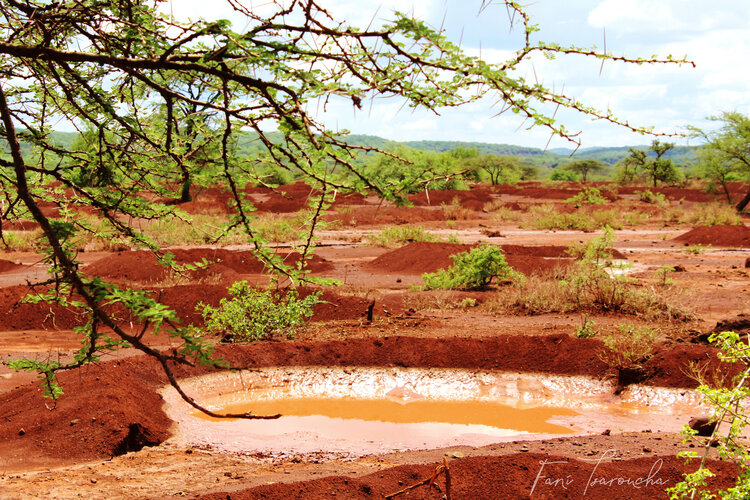
Keep the Water In
The newly constructed semi-circular bunds retaining the first rainwater in the beginning of the short rainy season, early in November, at Kuku.
The semi-circular shaped soil and water conservation interventions are popular solutions to land degradation, in semi-arid areas, on a low slope. They are constructed so that the precipitated water does not flow away, as it would normally do in an unmanaged land. The past years, the effect of climate change on rainy season patterns appears to shorten the length of the season and have heavier (and more erosive) precipitation events. Semi-circular bunds, however, can milden this effect of climate change on the soil by retaining the water in the soil for a prolonged period.
In a degraded unmanaged land, after every rainfall event, the fertile surface topsoil can be washed away together with water. The “semi-circular bunds” prevent erosion and provide the appropriate moist and nutrient content for vegetation to grow and stay green for longer, after the rainy season. Dry bio-degraded material from the previous seasons acts cumulatively as favorable soil material for more vegetation to grow. This process works in a virtuous cycle that was generated by the semi-circular bunds. The re-greening impact of the semi-circular bunds has been already noticed in areas where they have been constructed.
However, the aspiration of the project does not stop on the short-term regreening and restoring effects. The ides of strategically installing a network of the regreening plots across an area close to Mount Kilimanjaro and its glacier aspires to impact the local micro-climate and subsequently the macro-climate of the broader area.
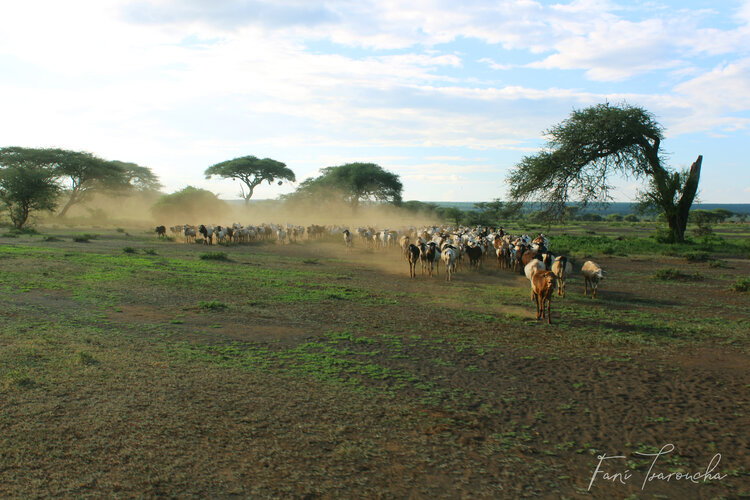
A Healthy Business
A big herd of ships and goats is moving to the higher elevations of the Chyulu hills, in the end of the short rainy season, late in December, at Kuku.
The Maasai people are traditionally pastoralists. Their herds are usually consisted by cows, goats, sheeps and donkeys (“enketeng”, “enkine”, “enkerr” and “osiria” in kimaasai language). The animals are considered as wealth or even as part of the family. The bigger the herd someone owns, the more respected he is by the community. In the past, the Maasai rarely did any trade with their animals and they were fed by them only in special occasions. Milk however has always been one basic element of their nutrition.
The Maasais work with their animals since very early age. They migrate with their herds to lands with the most grass and water, following the rainfall and vegetation patterns of either the wet or dry seasons. They may walk dozens of kilometers per day.
Climate change may have devastating effects to the Maasai communities. The past El Nino was reported to have caused severe drought, with consequent animal and human starvation incidents, in several East African areas. However, studies have found that pastoralist communities, such as the Maasai, have performed significant adaptive behavior to climate changes in the past.
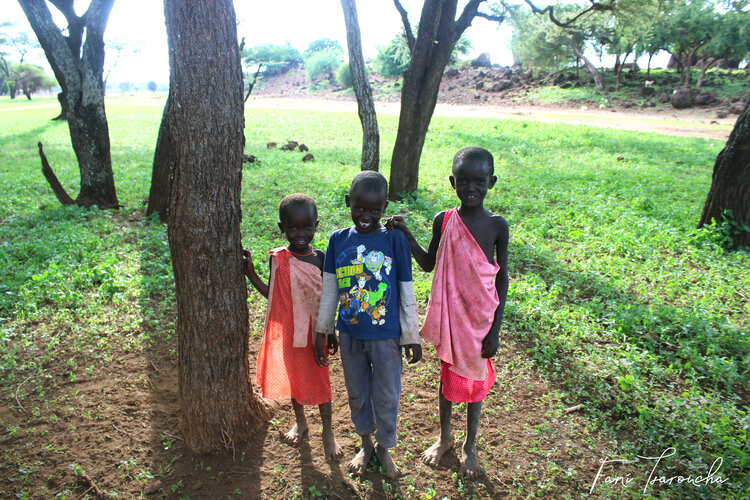
Generations in Transition
Maasai kids at the Oerata boma, in Kuku Group ranch.
When I first visited the Maasai land, I met a culture in transition from the traditional way of living to a more modern approach of the Kenyan countryside lifestyle. It is more likely for the children of the newest generations to go to school, more than ever before. School gives them the opportunity to access more life-choices. However, it seems as the choice of living as a Maasai pastoralist may not be such an appealing one anymore. I kept wondering what could the role of school be on empowering the intrinsic Maasai identity and what do these Maasai kids at the Oerata “boma” (word for village in Kimaasai language) want for their future?
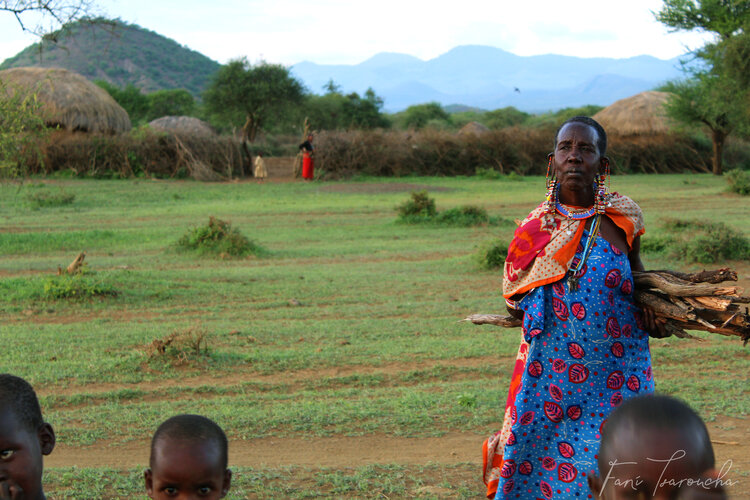
Woman: the Builder
A Maasai woman is fetching wood.
Traditionally, among the several roles of women in the Maasai communities, there is also that of the house builder. Either for the settlement of a new family on a Maasai “boma” or for the temporal allocation of settlements, women are fully responsible for the building of the houses from the supply to the construction phase. The main materials for the construction of the houses is clay, water, cow manure, wood and foliage from reeds or from spikey bushes for the roof top or for the fence that frames the “boma”.
Maasai women work a lot on a daily basis on several demanding tasks such as fetching water and wood, cooking, taking care of the children and the animals, or even building the houses. However, regardless of their enormous contribution to the household and to the community, Maasai women are unproportionally respected and they do not have a sound, powerful voice.
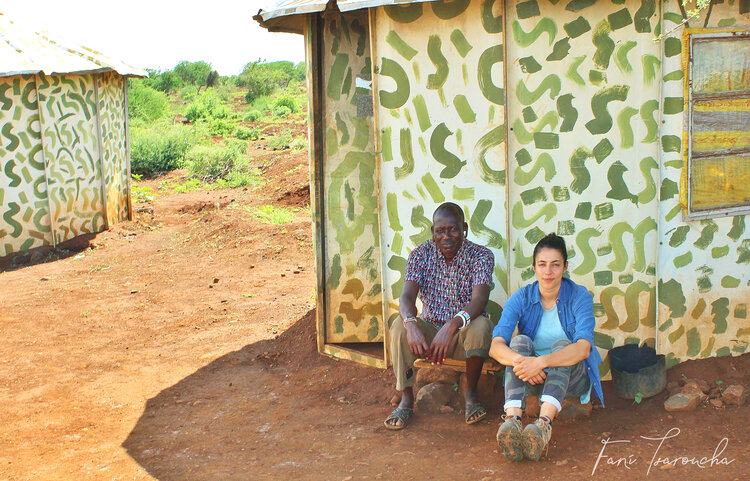
Petro: the Wisest Ranger
Having a lunch break with Petro, the wise Maasai ranger.
Petro is one of the oldest rangers of Kuku group ranch with a very kind personality. Every day, together with his colleagues he patrols over a big area to monitor animal populations or report any incidents involving wildlife and local communities. The area under his patrol includes the plot where the semi-circular bunds were also constructed. One day, on my way to my study-plot together with Petro, we heard voices from a Moran squad hunting two female lions. These lions had killed some of the community animals. Luckily, no Moran or lion was hurt, and the local authorities responded immediately by compensating the families for the cattle loss.
Lion killing was considered as a heroic act by the Maasai culture, but as part of conservation efforts, this custom is now being eliminated. Kenyan environmental policies and conservation organizations are attempting to “transform” the lion killing tradition of the Maasai. Currently, the young Maasai (both men and women) have the choice to obtain training in wildlife conservation and work as forest and savannah rangers. The training mainly includes the protection of wildlife from poaching and the resolution of human-wildlife conflicts. However, there is already a lot of traditional Maasai knowledge on conservation and wildlife behavior that I hope is incorporated in their training as rangers.
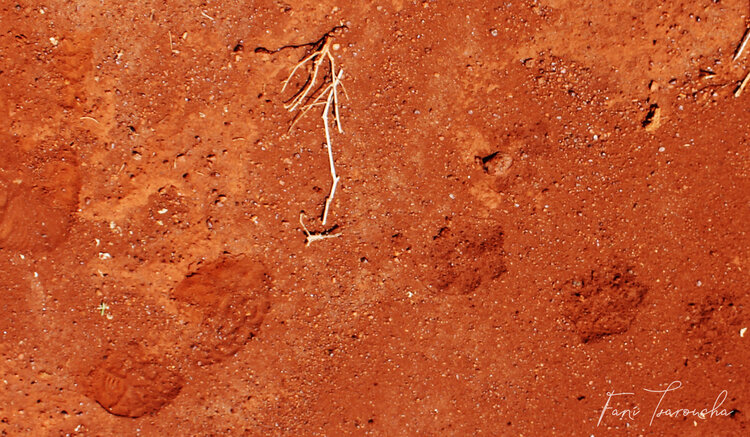
Symbiosis
A lion footprint next to a human footprint in the plot with the semi-circular bunds.
The overall wildlife population in Kenya has dropped rapidly over the past 30 to 40 years to less than one third. The two most important factors that led to this decrease are poaching and loss of natural habitat. Climate change acts as an additional factor threatening wildlife well-being, because of changes in temperature, water availability, food and vegetation patterns. The only lands across Kenya where human activity does not impact the existence and the populations of wildlife are Natural Parks and Conservancies, rangelands or a minor percentage of lands where people still live as hunter gatherers at the East-South coast of Kenya. Pastoralism is an ancient activity that has developed in balance with the existent ecosystem. In the Maasailands humans, cattle and big mammals can share the same ecosystem in absolute symbiosis.
If the Maasais were not pastoralists and were settled farmers instead, there would be no lions now to roam in the Maasailand.
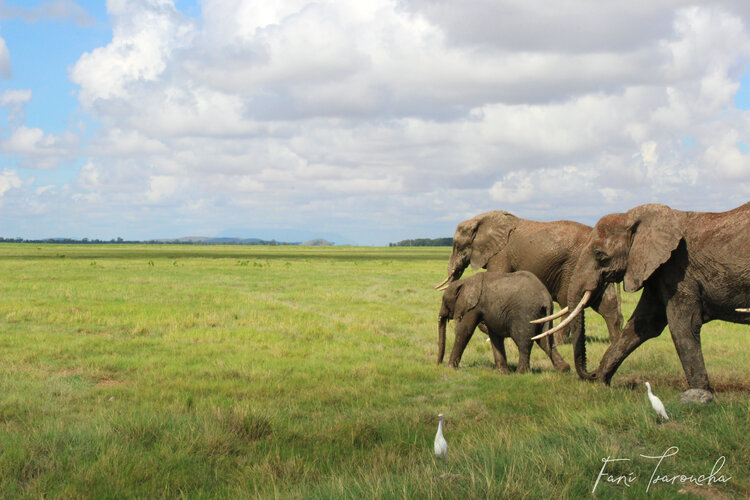
Crossing through Centuries
The leading female elephant and her herd, including calves, are trying to continue their passage during their migration towards the South, in Amboseli National Park.
Exactly like the Maasai, elephants are also very climate resilient. Every year, African Elephants in East Africa migrate from Kenya to Tanzania and backwards following rain patterns and seasonally emerging grasslands. Every year, these extraordinary creatures step on pathways that have been carved for centuries, utilizing the natural resources in an optimal way. Usually, if the passage of the herds is somehow interrupted, elephant herds do not risk finding new pathways. They are rather forced to graze over the same area which may not provide enough food during the dry season. A big number of elephants die from starvation every year. Factors that usually interfere with the ancient elephant pathways in East Africa are cases of claiming new agricultural, urban or industrial land, or cases of the development of railway or road network.
An old female is always the one that leads the way for the herd, following pathways that have been carved for centuries. Some studies mention that the leading female trackers may diverge only few centimeters from the carved pathway. Road and railway network planning in Kenya are currently using this knowledge. Based upon this knowledge road construction companies diverge the roads or build tunnels and the elephants can keep uninterrupted on their way to survive climate changes.

Should I trust the M’zungu?
Celina, together with other kids from Oerata, is showing me around the boma
The six-year-old Celina Nchoni is the daughter of a local Maasai pastoralist and a good friend of mine, Manuel. Manuel and his wife were both working for the construction of the semi-circular bunds. We spent a lot of time together with him and his family during the project and we are still in regular contact. They were blindly trusting the project, all the m’zungus involved (m’zungu in Swahili literally means the person that moves around in circles, in other words a “tourist”, and is now generally used for white people) and me. They were counting on our presence in their land and they showed great gratitude towards us.
After I left them, a heavy drought impacted severely Manuel’s family, as they lost several animals from starvation. At that time, they could not financially support the school fees for Celina, her sister and brothers. At some point, my dear friend Manuel was even forced to sell his piki piki (local word for “motorbike”) which was an important source of income for the family. It was very surprising to realize the extent of climate impact on a personal level, for my friend. Climate change can severely affect the Maasai families even after only a short amount of time.
The extension of the soil moisture and the vegetation inside the semi-circular bunds after the rains could be noticed as short term effects of the interventions. However, only the long-term effects of semi-circular bunds on a multi-year scale could have clear impact on the livelihood of the locals. I really hope that the future will reward them for all the trust they showed to this.
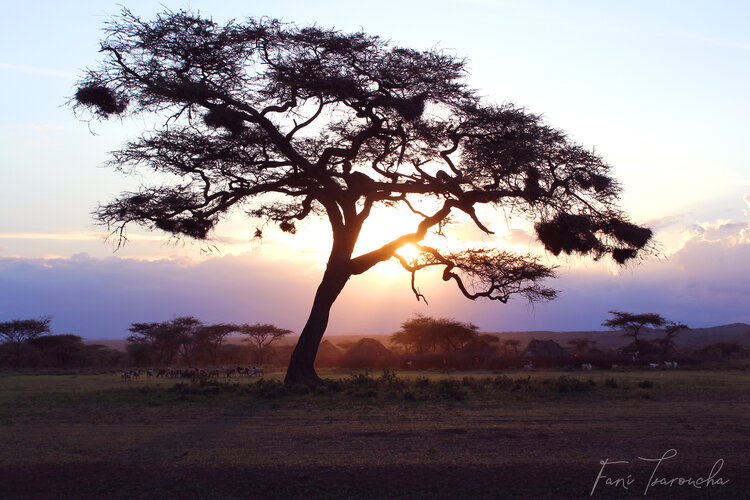
A Sunrise or a Sunset
The sun is hidden behind an Acacia tree next to a Maasai boma in Kuku group ranch. Can you distinguish if this is a sunrise or a sunset?
In a country facing rapid societal, climate and environmental transitions, the sustenance of the pastoral Maasai culture and the peaceful symbiosis with the savannah are highly vulnerable. Can a land conservation and water restoration project like the one in Kuku Group Ranch help the Maasai to sustain and empower their beautiful culture through this changing world? Can we distinguish between a beginning and an ending? Can we distinguish between a sunrise and a sunset?
JOIN THE MOVEMENT
Fani Tsaroucha

